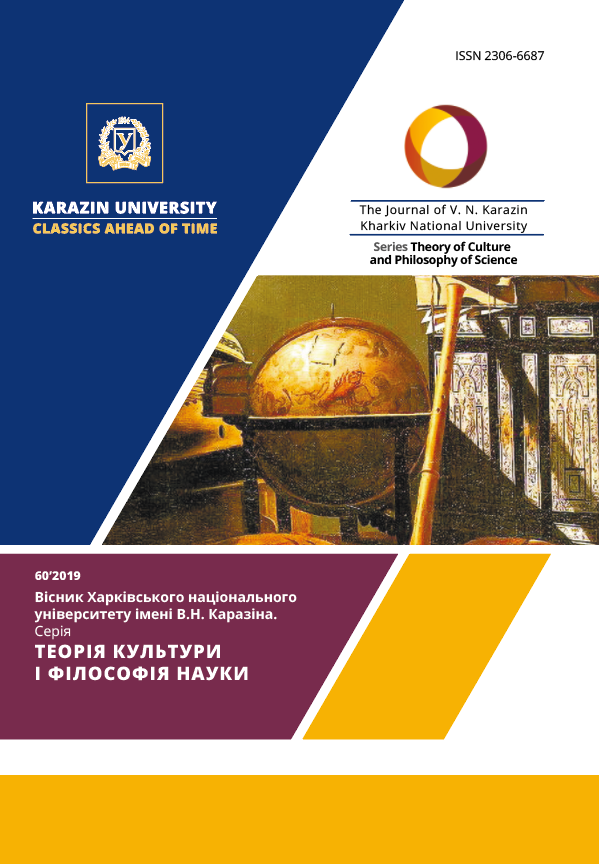PHILIPPE GRANDRIEUX’S TRANSVERSAL CINEMA
AFFECT, GESTURE, TOUCH
Abstract
The article deals with the examination of philosophical reflections as to the interrelation of a film and philosophy. The purpose of article is to research the anthropological aspects of various directions in philosophy of cinema forming from the beginning of the XXI century. The presented research will also help to designate the feature of the articulation of “human body/visual image” in the modern philosophical and culturology conceptions.
The examination of philosophy of cinema of the end of the beginning of the XXI century allows allocating of several strategies for understanding the subject “a body and image”. These strategies of philosophical anthropology of cinema do not present integrally all possible directions of conceptualization of the interrelation of an affect and image in Grandrieux’s films. Yet, the given schemes have drawn the basic configurations of dispositives, which distribute the economy of the human/animal, natural/artificial, inherent/cultural, human/technical. The specified strategies are evident not only in various philosophical conceptions, but also in theoretical research of cinema, which deal with the studies of the subject “a transversal and film”.
In a number of modern philosophical conceptions, the transversal concept is defined even more broadly and is corresponded to the concept of actual. The transversal in Grandrieux’s films is an extension of the visual turn and is one of the most important tendencies of hot cognition.
Therefore, in the philosophy of the beginning of the XXI century the interpretation of Grandrieux’s films is used in three nominal deuce: 1) image and affect; 2) dispositive and transversal; 3) vision and touch. These strategies of reconstruction of Grandrieux’s films do not present integrally all possible.
Downloads
References
Гранрийе Ф. 23 режиссера. Интервью Дмитрию Волчеку. 2011. URL: http://archive.svoboda.org/programs/cicles/cinema/23/07.asp.
Гранрийе Ф. Стараюсь разрабатывать связь между аффектами и историей. Искусство кино. 2014. URL: http://kinoart.ru/blogs/filipp-granrije-starayus-razrabatyvat-svyaz-mezhdu-affektami-i-istoriej.
Делез Ж. Фрэнсис Бэкон: Логика ощущения / пер. с фр. и послесл. А. В. Шестакова. Санкт-Петербург: Machina, 2011. 176 с.
Эко У. Отсутствующая структура: Введение в семиологию /пер. с ит. А. Погоняйло и В. Резник. Санкт-Петербург: Симпозиум, 2006. 544 с.
Эпштейн Ж. Чувство / пер. с фр. С. Юткевича. Из истории французской киномысли: Немое кино 1911–1933 гг. / сост. М. Ямпольский. Москва: Искусство, 1988. С. 80–140.
Agamben G. Notes on Gesture. Means Without Ends. Notes on Politics. Minneapolis, MI; London, UK: University of Minneapolis Press, 2000. 156 p.
Balibar E. Individualité et Transindividualité chez Spinoza. Architectures de la Raison. Mélanges offerts à Alexandre Matheron. Paris: ENS Éditions, 1996. P. 35–46.
Chamarette J. Phenomenology and the Future of Film: Rethinking Subjectivity Beyond French Cinema. New York, NY; London, UK: Palgrave Macmillan, 2012. 271 р.
Dolar M. A Voice and Nothing More. Cambridge, MA: The MIT Press, 2006. 224 р.
Grandrieux P. The Body’s Night. An Interview with Philippe Grandrieux. Rouge, 2002. URL: http://www.rouge.com.au/1/grandrieux.html.
Spinoza B. Ethik. Opera. Heidelberg: Heidelberg Akademie der Wissenschaften. 1925. Bd. 2. S. 43–308.
Warburg A. The Renewal of Pagan Antiquity. Los Angeles, CA: Getty Research Institute for the History of Art and the Humanities, 1999. 868 p.




